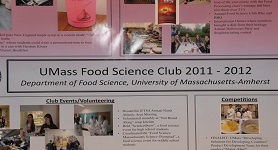By: Thomas Siebertz
I love going out to eat, whether I’m trying out a new restaurant or just getting together with friends at our usual spot. As a food inspector and student of food science, when I go out, I look at everything critically, whether it’s the cleanliness of the restrooms, water spots on my silverware or even a ceiling tile out of place. Some people say I’m too critical but I don’t think you can even be too conscious about food safety.
I notice a lot of restaurants use paper menus, either as place mats or brochures that can be discarded after use. However, some use the plastic or laminated ones that get reused over and over. I have always wondered how sanitary these menus were. Are they cleaned and sanitized after people touch them or get food on them? Thanks to an article in the Journal of Environmental Health, my questions have been answered!
The article, entitled “Persistence of Salmonella and E. coli on the Surface of Restaurant Menus” highlights research done by Sujata A Sirsat, PhD, Jin-Kyung K. Choi, PhD, and Jack A. Neal, PhD to see if bacteria can survive on menus and if they are transferable. The intro of the article discusses some important stats: the Centers for Disease Control (CDC) estimate that each year 48 million Americans get sick, 128,000 are hospitalized, and 3,000 die of foodborne disease (CDC, 2011). Data from 1998 to 2002 shows that about half of foodborne outbreaks occurred in restaurants.
The article also goes into detail about methods and materials, but I think the most interesting part is the results. In the study, actual menus were sampled from restaurants in Houston, TX and tested for aerobic microorganisms. They also inoculated menus with E. coli and Salmonella to quantify survival rates. Of the laminated menus sampled, they found that the menus had 1 to 2 log CFU/cm2 of aerobic microorganisms. Of the inoculated menus, bacteria did not survive on the paper menus beyond zero hours. However, both E.coli and Salmonella persisted on the laminated menus. The article states approximately 2.7 log CFU/cm2 of E. coli survived on the menus for up to 24 hours. Salmonella survived on the menus for 0-24 hours.
The researchers concluded that microorganisms can survive more efficiently on laminated vs. paper menus. They also concluded that microorganisms could be transferred from damp menus to fingertips for up to 24 hours, suggesting a possibility of cross contamination exists that could lead to illness. Since laminated menus are easier to sanitize, the researchers state that it is crucial for restaurant managers to schedule routine cleaning and sanitizing of menus.
If you have a chance, read the full article in this month’s Journal of Environmental Health!
Does this get you thinking about what’s on the menus at your favorite food spots?
Photo credit: http://a.abcnews.com/images/WNT/abc_wn_salmonella_100824_wg.jpg






It is great to hear some data on the sanitation of restaurant menus! People tend to make fun of me for always washing my hands after ordering at a restaurant to avoid getting sick from the menus or anything else. Goes to show that some items we take for granted could actually contribute to our health or lack their of. Bottom line is good hand washing and awareness! Thanks for sharing Thomas.
Yeah at some places you wonder how they get away with using dirty menus. I would think the health inspector would say something about that but I’ve seen some pretty bad ones. Things like that make me think they aren’t paying attention to other details in the kitchen. A restaurant I went to recently had dirty,worn menus and I also noticed the servers handling bread rolls with their bare hands and cooks eating and drinking in food prep areas. Who knows what other food safety issues are going on there.